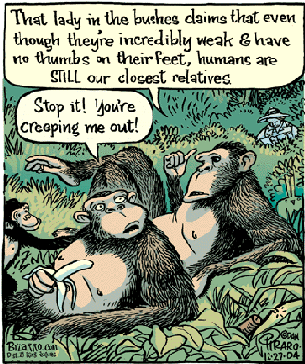What about the eyeball?
 A prominent and generally supportive article in my Saturday morning Globe & Mail about a creationist biology teacher managed to annoy me yesterday, and my evil letter-to-the-editor-writer twin emerged from hiding. Too bad they limit letters to 200 words! Or maybe that's a good thing...
A prominent and generally supportive article in my Saturday morning Globe & Mail about a creationist biology teacher managed to annoy me yesterday, and my evil letter-to-the-editor-writer twin emerged from hiding. Too bad they limit letters to 200 words! Or maybe that's a good thing...
If Bob Giza wants to advocate "intelligent design" (Putting God’s fingerprints on high-school biology, Oct. 8) more power to him. It's always fun to watch the dexterity with which the advocates of the new creationism dance away from the facts.That felt better...
So "what about the eyeball?" Creationists regularly trot out this question because it strikes a chord with un-informed audiences. A class of high-school students is clearly irresistible. In fact there are a wide range of vision mechanisms found in nature. Many are primitive variations that give insight into how our own eyes evolved or illustrate entirely different paths toward the same capability. The eyeball of the octopus, for example, looks like our own but is built quite differently. Scallops have a primitive version of "eyes", as do snails and some insect larvae.
So what about the eyeball? In fact the eyeball is an excellent example of the processes that we call "evolution". It is not the nail in evolution's coffin, and no tap from the wand of God (err, the intelligent designer) is required.
Unfortunately my response to Mr. Giza's misstatements will only be seen by the readers that scan your paper's Letters to the Editor. If Michael Valpy's article had not simply repeated Bob Giza's assertions your readers may have turned the page informed instead of deceived.
| Listening to: Mysterious Ways by U2 from Achtung Baby. |  |





No comments:
Post a Comment